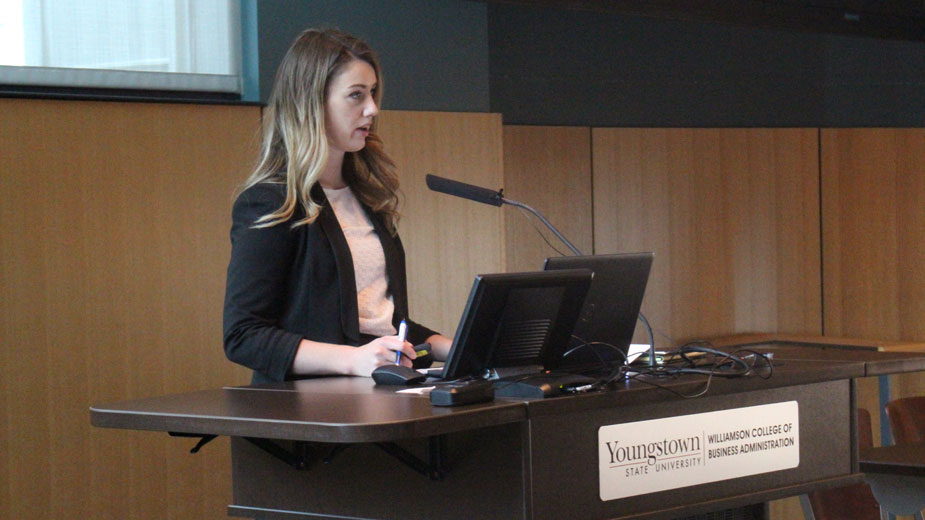Chamber Outlines Opportunity Zones Minus White House Reps
YOUNGSTOWN, Ohio – Many details remain to be ironed out for the new Opportunity Zone program, but the federal initiative is already drawing interest in local properties, both inside and outside the designated areas.
The Youngstown/Warren Regional Chamber unveiled its Opportunity Zone prospectus Monday at Youngstown State University’s Williamson Hall.
Originally intended to coincide with a visit by presidential adviser Ivanka Trump, Housing and Urban Development Secretary Ben Carson and other federal officials, the chamber went ahead with its event Monday despite the White House postponing the visit in the wake of the mass shooting in Dayton early Sunday.
“We thought it was important enough to move forward so we can start using this tool to market our area for additional investment,” said Lauren Johnson, 422 Corridor and business development manager for the Regional Chamber.
“We are competing with 8,700 other census tracts designated across the United States,” she said. So it’s important we are proactive in marketing these for additional investment, as well as supporting potential projects that may happen here anyway and need that additional push to get over the finish line” she added.
The 28-page document, available at the chamber’s website, highlights available properties and investment opportunities in the 15 designated Opportunity Zones in the Mahoning Valley – 10 in Mahoning County and five in Trumbull County.
The purpose of the federal program, created in December 2017, is to direct capital into distressed neighborhoods by creating a tax incentive for investors to target unrealized capital gains into eligible projects in disinvested communities.
Since the creation of the program and the designation of census tracts by the Department of the Treasury and the Internal Revenue Service, the chamber has received several questions about the initiative and few economic development tools have received as much attention, she said.
“That’s for good reason,” Johnson said. “Although there are still some unresolved questions that await clarification from the Department of Treasury and the IRS, the one thing that is clear is that this program has enormous potential to target additional investment into the Mahoning Valley.”
U.S. investors and companies have some $6.1 trillion in unrealized capital gains, she pointed out, money that could be targeted into census tracts like the 15 designated locally. The local tracts have a combined population of 35,000 and include areas covering the Mahoning Valley’s two major downtowns, several industrial parks and commercial areas.
Even without the prospectus, there has been a lot of interest in the program from potential investors and some pending local projects might take advantage of the tool, Johnson said.
“We’ve found that as folks consider Opportunity Zone projects they’re also considering projects outside of Opportunity Zones. So we may have an even bigger impact from the project than we first thought,” she said.
The prospectus might provide an investor’s first – and in some cases only – introduction to the community, particularly to national investors who are looking for projects in eligible areas.
Highlighting the Valley’s location, access to larger markets and local business incubators, the prospectus includes “detailed information” on recent investments in each census tract as well as available properties and targeted investment types “to market the most shovel-ready opportunities,” she said.
Anthony Trevena, economic development director for the Western Reserve Port Authority, reported his agency has received inquiries from developers about whether properties they are looking at are in Opportunity Zone tracts.
“It’s got the potential of being a real game-changer,” Trevena said. The program will add a layer to the existing incentives the agency works with, including historic and new market tax credits.
Jim Grantz, broker associate with Youngstown real estate firm Edward J. Lewis Inc., is encouraged by the incentive program’s potential. “It provides an opportunity to strengthen exiting projects and plans in the future,” he said.
Paul Johnson, president of Adolph Johnson & Son Co. in Mineral Ridge, is a member of the partnership that owns the former General Electric property south of downtown Youngstown. The 2.9-acre parcel is just outside an Opportunity Zone. “If things develop on the other side of the river, perhaps it’ll spill over to the area,” he said.
Other federal agencies are aligning programs to further incentivize investment in the zones. An Opportunity Zone project receiving financing from the Small Business Administration’s 504 loan program now can take advantage of relaxed job creation or retention requirements: one job per $85,000 of SBA financing rather than the usual $75,000 per job standard.
“We expect additional changes as the White House continues to look at this,” Johnson said.
At the prospectus unveiling, Jim Kinnick, executive director of Eastgate Regional Council of Governments, provided a brief update on the $600,000 grant from the U.S. Economic Development Administration to assist the Mahoning Valley plan for a future without the GM Lordstown Complex.
Eastgate and local partners including the chamber and the port authority will use the grant and the $150,000 local match to fund a recovery plan coordinator or team, using a study completed by Cleveland State University in March to assess the impact of the GM plant’s closing as a framework, Kinnick said.
Pictured: Lauren Johnson, 422 Corridor and business development manager for the Youngstown/Warren Regional Chamber, detailed the 15 local tracts designated as part of the federal Opportunity Zone program.
Copyright 2024 The Business Journal, Youngstown, Ohio.



